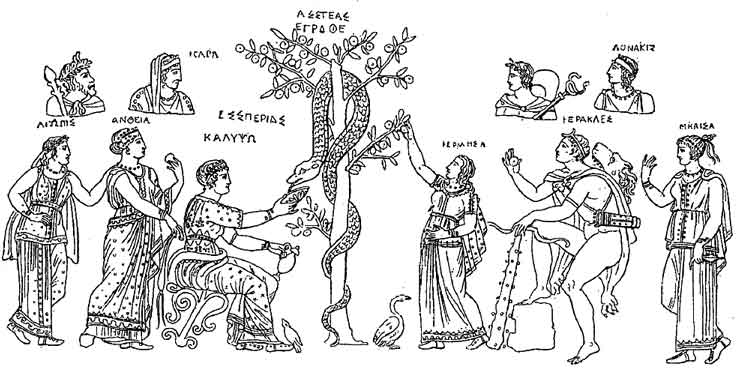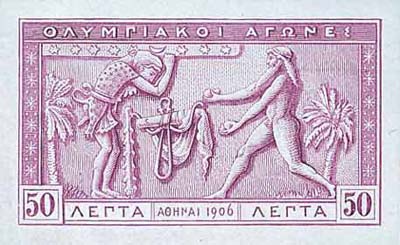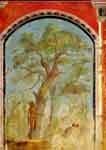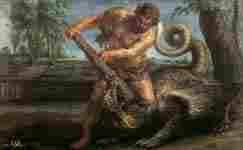.

Heracles and the Hesperides
In Greek mythology, the Hesperides are nymphs who tend a blissful garden in a far west corner of the world, located, according to various sources, in the Arcadian Mountains in Greece, near the Atlas mountains in Libya, or on a distant island at the edge of the ocean.
Additionally, Hesperides (also called Fortunate Isles) is a name given by the ancients to a series of islands located to the extreme west of the then known world. These may have included the Canary Islands, the Madeira Islands, and Cape Verde.
The evening
According to different accounts, there were either three, four, or seven Hesperides, but they are usually numbered three, like the other Greek triads (the Three Graces and the Moirae). Among the names given to them are Aegle ("dazzling light"), Arethusa, Erytheia (or Erytheis), Hesperia (or Hespereia), Hespere (or Hespera), Hestia, and Hesperusa. They are sometimes called the Western Maidens, the Daughters of Evening, or the Sunset Goddesses, all apparently tied to their imagined location in the distant west, and Hesperis is appropriately the personification of the evening (as Eos is of the dawn) and the Evening Star is Hesperus. They are also called the African Sisters, perhaps when thought to be in Libya. In addition to their tending of the garden, they were said to have taken great pleasure in singing.
They are sometimes portrayed as the evening daughters of Night (Nyx) and Darkness (Erebus), in accord with the way Eos in the farthermost east, in Colchis, is the daughter of the sun titan Hyperion. Or they are listed as the daughters of Atlas, or of Zeus and either Hesperius or Themis, or Phorcys and Ceto.

Heracles in the Garden of the Hesperides,drawing from a vase painting
The Garden of the Hesperides
The Garden of the Hesperides is Hera's orchard in the west, where either a single tree or a grove of immortality-giving golden apples grew. The apples were planted from the fruited branches that Gaia gave to her as a wedding gift when Hera accepted Zeus. The Hesperides were given the task of tending to the grove, but occasionally plucked from it themselves. Not trusting them, Hera also placed in the garden a never-sleeping, hundred-headed, dragon, named Ladon, as an additional safeguard.
Although Herakles was only supposed to perform ten labours, Eurystheus discounted those where he was aided or paid, and so two additional labours were given. The first of these (the eleventh overall) was to steal the apples from the garden. Heracles first caught Nereus, the shape-shifting sea god, to learn where the Garden of the Hesperides was located.
In some versions of the tale, Herakles did not know where to travel, and so sought help, being directed to Prometheus to ask, and when reaching Prometheus freed him from his torture as payment. This tale is more usually found in the position of the Erymanthian Boar, since it is associated with Chiron choosing to forgoe immortality and to take Prometheus' place.
In some variations, Herakles, either at the start or at the end of his task, meets Antaeus, who was invincible as long as he touched his mother, Gaia, the earth. Antaeus was killed by placing him above the earth, suspended in a tree.
Occasionally, versions tell that Herakles stopped in Egypt, where King Busiris decided to make him the yearly sacrifice, but Herakles burst out of his chains.
Finally making his way to the Garden of the Hesperides, Herakles tricked Atlas into retrieving some of the golden apples for him, by offering to hold the heavens for a little while (Atlas was able to take them as in this version, Atlas was the father of the Hesperides). Upon his return with the apples, Atlas decided not to take the heavens back from Heracles, but Heracles tricked him again by agreeing to take his place on condition that Atlas relieved him temporarily so that Herakles could make his cloak more comfortable. Atlas agreed, Heracles walked away. According to an alternate version, Herakles slew Ladon instead.
Herakles was the only person to successfully steal the apples, although Athena later returned the apples to their rightful place, in the garden.

Atlas offers the Hesperides apples to Heracles, drawing from a Lekythos, Athena painter, c. 490/480 BC, National Archaeological Museum Athens, Inv. 1132..
Origin
Directly above Libra is the constellation Ursa Minor. Ursa Minor was only considered a constellation after the 6th century BC, at which point it was thought of as a small bear. Before that time it was considered to be seven sisters, specifically, the Hesperides, who also formed the wing of the constellation Draco (although in since Roman times, the wing has been no longer thought of as part of Draco).
The constellation Ursa Major lies between Ursa Minor and the ecliptic of Libra. In ancient times it was thought of as an apple tree, having its three apples, the brightest stars in its constellation, in what is now considered the bear's tail. Between Ursa Minor and Ursa Major is the constellation Draco, the dragon, which appears to be protecting both the tail stars, the apples, of Ursa Major, and sits as the front line behind which are the stars of Ursa Minor. Draco looks menacingly toward the sun when it is in Libra.
Intimately associated with this group of constellations is the constellation of Boötes, which is between them and Libra. Early legends concerning the constellation of Boötes reflected the fact that parts of it are close to Polaris, the pole star, and as such, it was considered to be the man who held up the heavens, Atlas. His three sets of seven daugters were considered to be the groups of small constellations of seven stars, the Hespirides, the Hyades, and the Pleides. Boötes appears to be heading toward Ursa Major and Ursa Minor (which is why it is also known as the Bear Watcher).
The greeks did not consider Libra as a separate constellation (considering it part of Scorpio), it is uncertain as to what took its place, but it may have been Boötes, since it is a large constellation in the approximate area. Since Boötes is not actually on the ecliptic, or part of the zodiac band, the place it should occupy in the zodiac itself is vacant, and thus the sun, when in Libra, can be said to have taken its place.
The presence of the giant Antaeus in some tellings of the tale may be indicative of a second application of the constellations, namely a myth concerning Boötes, and how Boötes is not in contact with the ecliptic, though it stands as if it ought to be.
Busiris, an egyptian, is generally thought to be a corruption of the name Osiris, and his myth a corruption of the sacrifice of Osiris (a sun god) by Seth, representative of the apparant freezing of the sun's path on its ecliptic during the two weeks after the solstice (its being bound), and its near death (i.e. the solstice itself). The tale's presence, unconnected with Libra, may have originated when the connection to the Zodiac was lost, and an association was made instead with having to travel to the Atlas mountains via africa, and hence via egypt.
| Nymphs | |
Pausanias
The Phliasians tell also the following legend. When Heracles came back safe from Libya, bringing the apples of the Hesperides, as they were called, he visited Phlius on some private matter. While he was staying there Oeneus came to him from Aetolia. He had already allied himself to the family of Heracles, and after his arrival on this occasion either he entertained Heracles or Heracles entertained him. Be this as it may, displeased with the drink given him Heracles struck on the head with one of his fingers the boy Cyathus, the cup-bearer of Oeneus, who died on the spot from the blow. A chapel keeps the memory of the deed fresh among the Phliasians; it is built by the side of the sanctuary of Apollo, and it contains statues made of stone representing Cyathus holding out a cup to Heracles.
Link
'The Garden of the Hesperides' (http://www.liverpoolmuseums.org.uk/picture-of-month/displaypicture.asp?venue=7&id=137) in the Lady Lever Art Gallery (http://www.liverpoolmuseums.org.uk/ladylever/index.asp)
See also : Greek Mythology. Paintings, Drawings
| Ancient Greece
Science, Technology , Medicine , Warfare, , Biographies , Life , Cities/Places/Maps , Arts , Literature , Philosophy ,Olympics, Mythology , History , Images Medieval Greece / Byzantine Empire Science, Technology, Arts, , Warfare , Literature, Biographies, Icons, History Modern Greece Cities, Islands, Regions, Fauna/Flora ,Biographies , History , Warfare, Science/Technology, Literature, Music , Arts , Film/Actors , Sport , Fashion --- |
Retrieved from "http://en.wikipedia.org"
All text is available under the terms of the GNU Free Documentation License



